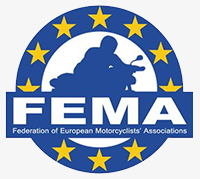The Members of the European Parliament approved the regulation on the approval of two- and three wheelers. Further amendments before the final adoption by the Council of Ministers are not expected. Motorcyclists welcome the agreed compromises. The regulation is setting new rules and technical requirements for manufacturers who sell motorcycles in the European Union
 In Strasbourg on 20th November, after two years of discussions, the European Parliament has approved (643 out of 677 votes in favour) the regulation on the approval and market surveillance of two- or three-wheel vehicles and quadricycles. As from 2016 member states of the EU will no longer have the option to restrict the maximum power output of motorcycles to 74 kW. New motorcycles with an engine capacity exceeding 125 cm³ (sub-categories A2 and A3) will have to be equipped with Anti-lock Braking systems (ABS) while light motorcycles (sub-category A1) between 51 and 125 cm³ will have to have at least Combined Braking Systems (CBS).
In Strasbourg on 20th November, after two years of discussions, the European Parliament has approved (643 out of 677 votes in favour) the regulation on the approval and market surveillance of two- or three-wheel vehicles and quadricycles. As from 2016 member states of the EU will no longer have the option to restrict the maximum power output of motorcycles to 74 kW. New motorcycles with an engine capacity exceeding 125 cm³ (sub-categories A2 and A3) will have to be equipped with Anti-lock Braking systems (ABS) while light motorcycles (sub-category A1) between 51 and 125 cm³ will have to have at least Combined Braking Systems (CBS).
Measures to prevent tampering of the powertrain are going to be installed on all new powered two wheelers with a performance of up to 35 kW (sub-categories B, A1 and A2). The riders organisations represented by FEMA successfully managed to exclude A3 motorcycles and sidecars from these measures. Similarly, special schemes for the approval of individually built motorcycles remain in place which means that the possibility to exempt custom motorcycles from some of the strict measures of this regulation remains.
Emissions limits for motorcycles will become stricter in two stages. In 2016 EURO 4 and in 2020 EURO 5 applies for new types of motorcycles (A1, A2 and A3). FEMA had called for high durability requirements to guarantee that emissions remain on a low level throughout the lifetime of the vehicle. The European Parliament has now decided that manufacturers will need to prove the durability of pollution control devices for a mileage of 35.000 kilometers.
In order to increase competition and to help especially small and independent workshops manufacturers will have to provide easy and unrestricted access to maintenance and repair information for their products. At the same time access ports to On-Board Diagnostic systems, whose installation will also be required as from 2016 for new motorcycles, are going to be standardised.
The categories, and emissions standards and durability requirements are shown in the box
| Vehicle categories (sub-categories) | Denomination | Restriction | Emission requirement (durability requirement) |
| L1e-B | two wheel moped | max speed 45 km/h
max power 4 kW |
Euro 3: 2014
Euro 4: 2017 (11.000km) Euro 5: 2020 (11.000km) |
| L3e – (A1) | Low-performance motorcycle | max 125 cm³
max 11 kW max 0.1 kW/kg |
Euro 4: 2016 (20.000km)
Euro 5: 2020 (20.000km) |
| L3e – (A2) | Medium performance motorcycle | max 35 kW
max 0.2 kW/kg not derived from an MC with an engine of more than double its power |
Euro 4: 2016 (35.000km)
Euro 5: 2020 (35.000km) |
| L3e – (A3)
|
High-performance motorcycle
Motorcycle with Sidecar |
no restriction | Euro 4: 2016 (35.000km)
Euro 5: 2020 (35.000km) |
| L3e – (AxT)
x=1,2 or 3 |
Trial motorcycles | Provisions regarding seat height, ground clearance, gear ration and mass in running order | according to A1, A2 and A3 norms (5.500km) |
| L3e – (AxE)
x=1,2 or 3 |
Enduro motorcycles | Provisions regarding seat height, ground clearance, gear ration and mass in running order | according to A1, A2 and A3 norms (11.000km) |
An environmental effects study, being carried out by the Commission by 2016, will consider the appropriateness of the Euro 5 stage. All dates valid for new models. Existing models will have to apply one year later accordingly.
No anti-tampering measures for A3 and French 100 hp limit skipped
The reaction of French riders on the decision of the European Parliament was extremely positive as France is the only country of the EU still making use of its right to refuse the registration of motorcycles with a maximum net power of more than 74 kW. As from 1stof January at the latest French riders will be able to purchase and register more powerful motorcycles in France – just like the riders in any other country of the EU already do.
The Commission originally proposed to equip all L-category vehicles (therefore everything on two or three wheels quipped with an engine) “with designated measures to prevent tampering of a vehicle’s powertrain” (laid down in Article 18). After lengthy and tough discussions with MEPs and national representative the member organisations of FEMA finally managed to exclude A3 motorcycles from such measures.
Now the text states: “Vehicle manufacturers shall equip L-category vehicles with the exception of subcategories L3e-A3 and L4e-A3, with designated features to prevent tampering of a vehicle’s powertrain” (compare Article 18 (2)). For motorcycles and sidecars unrestricted in power there will finally be no changes in this respect.
What exactly the measures “to prevent tampering of a vehicles powertrain” for mopeds and A1 and A2 motorcycles will consist of is still unknown. The European Parliament entitled the European Commission to work out the technical details via so-called delegated acts until the beginning of 2014. Similar uncertainty remains for many other technical details.
Debate in Parliament
Apart from the extremely EU-sceptical parties all political groups welcomed the Report of the Dutch member of the European Parliament (MEP) Wim van de Camp who was named Rapporteur of the regulation on behalf of the committee in charge, the Committee on the Internal Market and Consumer Protection (IMCO). As a result 643 out of the 677 MEPs present voted in favour of the text.
On 19thNovember, the night prior to the vote, the final debate on the type approval regulation was held in Parliament. Rapporteur Wim van de Camp once again highlighted the technical complexity of the regulation as the main reason why its approval had been delayed repeatedly. He also reminded the European Commission to provide enough room for stakeholders to contribute to the formulation of delegated acts. At the same time he asked the Commission to stick to the schedule in order to ensure adequate lead time for manufacturers.
EU Commissioner Antonio Tajani described the compromise text as the “result of intense discussions between the Commission, the Council and the European Parliament”. Mr. Tajani highlighted the improved access to repair and maintenance information as beneficial for the consumers and promised to have an eye on the development of the delegated acts.
British MEP and IMCO Chairman Malcolm Harbour underlined the environmental achievements of the regulation and the parliament’s contribution to provide manufacturers with sufficient time to cope with the new rules.
Irish MEP Gay Mitchell took the opportunity to criticise the Commission for having suggested the inclusion of motorcycles and scooters into the proposal for a new regulation on periodic roadworthiness testing. Like FEMA he sees no justification for such a step which would create additional and unnecessary financial burdens for Europe’s citizens.
Original Source – FEMA – Click Here


Speak Your Mind